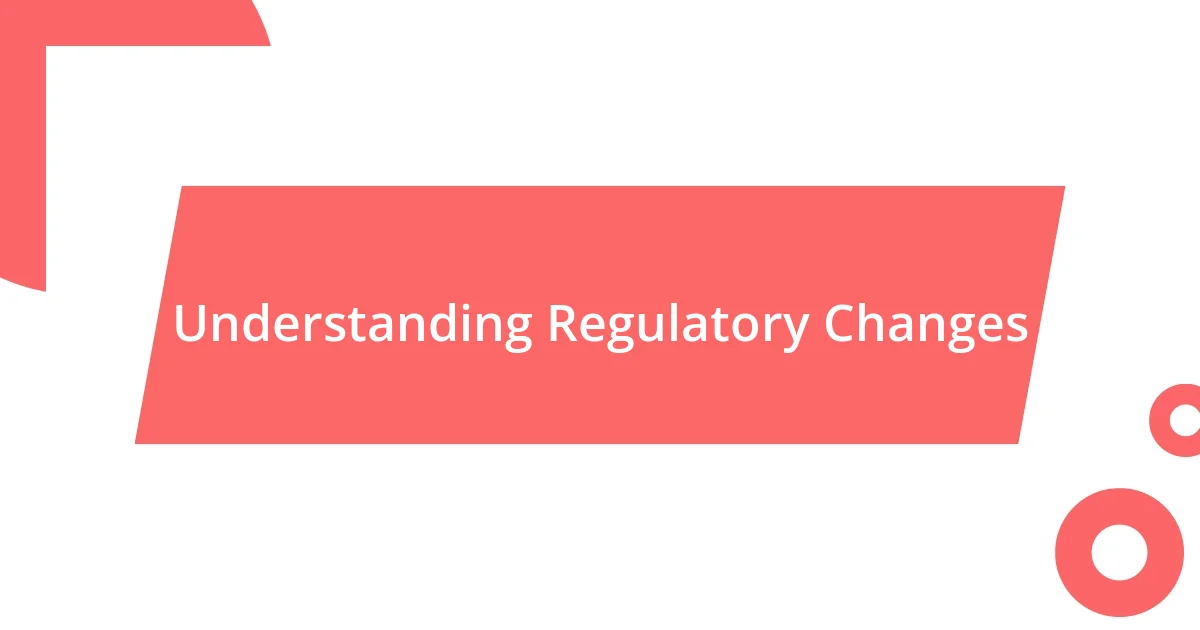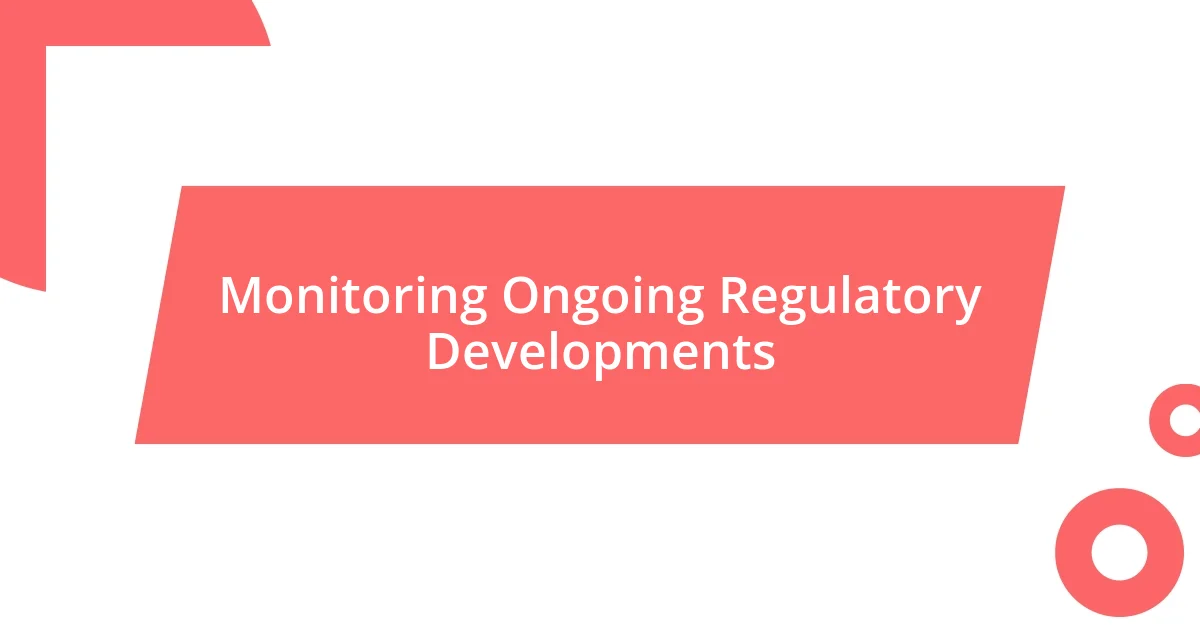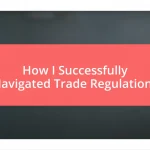Key takeaways:
- Understanding regulatory changes involves grasping the underlying reasons for the regulations, turning perceived obstacles into opportunities for improvement.
- Conducting gap analyses and involving stakeholders in response planning fosters a culture of accountability and enhances compliance efforts within an organization.
- Ongoing monitoring of regulatory developments and continual evaluation of responses ensure adaptability and effectiveness in compliance strategies.

Understanding Regulatory Changes
Regulatory changes can feel overwhelming, can’t they? I remember the first time I encountered a significant change in my industry; the sudden shift left me anxious about how it might impact my work. It’s like navigating uncharted waters; knowing the rules can either save you or sink you.
Adapting to these changes requires a keen understanding of not just what the regulations state, but also why they exist. When I took the time to dig into the reasoning behind a new regulation, I noticed it altered my perception entirely. Instead of viewing it as a hindrance, I began to see it as an opportunity to improve processes and enhance compliance.
It’s critical to stay ahead of the curve. I find that keeping an open conversation with peers and experts helps me grasp the nuances of regulatory shifts. Have you ever reached out for insights during a tough transition? Collaborating with others often turns out to be the best way to transform uncertainty into clarity and collective resilience.

Identifying Key Regulatory Impacts
Identifying key regulatory impacts can feel like piecing together a puzzle. I vividly recall a time when a new data protection law was introduced. Initially, it seemed daunting. However, by identifying the core impacts, like compliance costs and changes in data handling processes, I began to see a clearer picture of how my work would be affected.
As I dug deeper, I realized that keeping track of potential impacts wasn’t just about regulatory compliance; it also involved understanding market dynamics. For instance, when a green energy regulation came into play, my business landscape shifted. This gave me insights into new opportunities that could be explored. It transformed my initial dread into a proactive approach, highlighting the need for ongoing engagement with stakeholders to gauge how the impacts might evolve.
It’s essential to leverage a systematic approach to capture these impacts thoroughly. I often recommend creating a matrix to evaluate both the positive and negative implications. This helped me when confronting changes that could otherwise be viewed as purely burdensome. Engaging with the regulatory framework through organized assessments allowed me to respond with confidence rather than apprehension.
| Key Impact | Description |
|---|---|
| Compliance Costs | Increased expenses related to meeting new regulations. |
| Operational Adjustments | Changes needed in processes to align with laws. |
| Market Opportunities | New business avenues arising from updated regulations. |

Assessing Internal Compliance Gaps
Assessing internal compliance gaps is crucial in navigating regulatory changes. When my organization faced a new set of compliance requirements, I immediately sensed the urgency to conduct a gap analysis. It was like standing in front of a mirror, realizing that areas we thought were solid had cracks that needed filling. I gathered my team for a series of workshops where we explored every aspect of our operations to identify vulnerabilities.
Here are some key considerations that came out of our assessment:
- Current Policy Review: We scrutinized existing policies to ensure alignment with new regulations.
- Training Needs: Did our staff have the necessary knowledge? Identifying training gaps was vital.
- Compliance Monitoring: Establishing mechanisms to routinely check compliance became imperative.
- Resource Allocation: We evaluated whether we had the right resources dedicated to compliance efforts.
Detection of compliance gaps is not just a task; it’s a commitment to improvement. I remember feeling a mix of apprehension and resolve as we mapped out our current state against regulatory expectations. The process felt like throwing a net into a deep, murky lake, hoping to catch unseen issues lurking below the surface. By collaborating with my team, we turned our anxiety into strategic action points that not only enhanced compliance but also fostered a stronger culture of accountability across the organization.

Developing a Responsive Action Plan
Developing a responsive action plan requires a structured yet flexible framework to address regulatory changes effectively. I remember drafting my first action plan during a significant overhaul in environmental regulations. The process was thrilling, akin to creating a roadmap for a road trip—I had to consider my destination while accounting for potential detours along the way. I outlined clear objectives and timelines, which helped my team stay focused amid uncertainty.
One key element I incorporated was stakeholder involvement. Engaging team members from various departments not only provided diverse perspectives but also fostered a sense of ownership. I found that asking, “How does this change impact your role?” sparked innovative ideas and solutions that I hadn’t considered. It amazed me how collective brainstorming led to more comprehensive plans and, ultimately, smoother transitions.
As the plan took shape, prioritization emerged as another critical factor. I developed a tiered approach where immediate regulatory requirements were addressed first, followed by longer-term strategic initiatives. This helped my team manage workloads effectively, reducing stress during a time that could have easily spiraled into chaos. Reflecting on that experience, I realized that adaptability was essential—regulatory environments can shift quickly, and being prepared to pivot can make all the difference in ensuring compliance and maintaining operational efficiency.

Implementing Staff Training Programs
Implementing staff training programs is not just a box to tick; it’s truly the heartbeat of successfully navigating regulatory changes. I’ll never forget the moment I stood in front of my team, excited yet slightly anxious, as we embarked on our first comprehensive training initiative. Was everyone on the same page regarding the new requirements? I quickly realized that ensuring everyone understood the nuances of updated regulations felt like unraveling a complicated puzzle together.
To make the training effective, I utilized a mix of formats—workshops, e-learning modules, and even role-playing scenarios. I vividly remember the lively discussions that sprang to life during our workshops; it was inspiring to see staff members become not just recipients of information but active participants in the learning process. When I posed the question, “How can we apply this knowledge in our daily work?” the responses revealed a depth of understanding I hadn’t anticipated, highlighting capabilities within the team that hadn’t been tapped before.
Feedback loops became invaluable as we refined our training programs. After each session, I encouraged open dialogue about what worked and what didn’t. I recall the palpable energy in the room during these feedback discussions; it felt like we were all co-creators in this journey. By fostering a culture where employees felt comfortable voicing their concerns and suggestions, we cultivated an environment that not only embraced compliance but also promoted continuous learning and growth. Isn’t it fascinating how the act of training can transform not just knowledge but also team dynamics?

Monitoring Ongoing Regulatory Developments
Monitoring ongoing regulatory developments is an essential practice that I’ve continually refined throughout my career. There’s something invigorating about keeping a pulse on the landscape; it’s almost like being part of a live performance where the rules can change at any moment. I remember a time when I set up a dedicated team to scan industry news and regulatory reports weekly. The thrill of identifying trends before they became pressing issues was like being a step ahead in a game of chess.
The tools and techniques I employed were varied and strategic. I found using regulatory tracking software incredibly beneficial; it felt like having a reliable co-pilot navigating through treacherous waters. Additionally, I listened to webinars and attended conferences, and those engagements opened my eyes to a wealth of insights others were generously sharing. Was I really taking full advantage of the knowledge available? Reflecting on those experiences, I realized that these gatherings ignited discussions that spun off into creative solutions for potential challenges.
Incorporating a feedback mechanism with my team was vital in modifying our monitoring approach. There were moments when team members shared alerts about changes that had passed my radar. Each time, it felt like a collaborative victory. I often asked, “What other perspectives are we missing?” That question encouraged a culture of inclusivity and openness, allowing us to adapt more effectively. Ultimately, I’ve learned that the key to anticipating regulatory changes lies not just in the tools we choose, but in the conversations we foster within our teams.

Evaluating the Effectiveness of Responses
Evaluating the effectiveness of our responses to regulatory changes has been a learning journey for me. I remember after rolling out the compliance updates, I took the time to gather data on performance metrics and compliance rates. Seeing the numbers come in felt a bit like unboxing a surprise gift—was the effort worth it? The results painted a clearer picture of where we had succeeded and where we needed to shift our focus.
I began conducting one-on-one interviews with staff to dive deeper into their experiences. Hearing their stories added a personal touch to the dry data; for instance, one team member shared how the new procedures eased their workflow significantly, while another found certain processes challenging. Their insights were gold, prompting me to wonder: were we truly meeting the needs of everyone involved? This opened the door to adjustments that could further enhance our strategies.
Regular discussions with external stakeholders were also crucial in my evaluation process. I distinctly remember a meeting with a regulatory expert where their feedback illuminated gaps in our approach that we hadn’t recognized. It was a wake-up call! Engaging with outside perspectives not only validated our efforts but also provided fresh ideas, underscoring the importance of collaboration in refining our responses. How do we ensure our strategies remain effective over time? By embracing a mindset of continuous evaluation and adaptation, I believe we can navigate the regulatory landscape more confidently.















